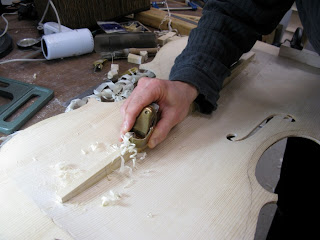


many more pictures of the finished instrument are available on my website : www.mondocellos.co.uk
 The very last bit of the making of our instruments is what's called the set up - all the free standing and removable parts, some of which can be adjusted to change the sound of the instrument.
The very last bit of the making of our instruments is what's called the set up - all the free standing and removable parts, some of which can be adjusted to change the sound of the instrument.
 As part of the commission of the cello I have agreed to create a dedication for Victoria, in whose it was made.
As part of the commission of the cello I have agreed to create a dedication for Victoria, in whose it was made.
 I accepted that UV light has a positive effect on my instruments.
I accepted that UV light has a positive effect on my instruments.
 The edge work - rounding around the edges - has been roughly started before the plates were glued to the body so to access easily the underside without damaging the ribs.
The edge work - rounding around the edges - has been roughly started before the plates were glued to the body so to access easily the underside without damaging the ribs. The "box" is now closed together for good. It takes a long time on a cello to insure that the ribs are set on both plates where there are meant to be - sometimes slight distortions of the ribs change their shape and they are to be "persuaded" back into place. This is the only way to guarantee no loss of overhang - the extra wood on the plates that makes the edges. The regularity of the overhang is purely esthetic, but that is so important.
The "box" is now closed together for good. It takes a long time on a cello to insure that the ribs are set on both plates where there are meant to be - sometimes slight distortions of the ribs change their shape and they are to be "persuaded" back into place. This is the only way to guarantee no loss of overhang - the extra wood on the plates that makes the edges. The regularity of the overhang is purely esthetic, but that is so important. We find it very important to support parts of the cello so as to lengthen its life and minimise the intervention of restorers in decades to come. This takes even more of our time but we respect our instruments to at least that point of giving them as much longevity as we can.
We find it very important to support parts of the cello so as to lengthen its life and minimise the intervention of restorers in decades to come. This takes even more of our time but we respect our instruments to at least that point of giving them as much longevity as we can. On a new instrument, it is rather nice that the fingerboard can be made before the neck is fitted, instead of using that we may call a "false fingerboard".
On a new instrument, it is rather nice that the fingerboard can be made before the neck is fitted, instead of using that we may call a "false fingerboard". Once glued, the bass bar is given a streamline shape. (This picture shows it just glued and unshaped)
Once glued, the bass bar is given a streamline shape. (This picture shows it just glued and unshaped) In the process of shaping the bass bar, we dispose of the wood on it that is unnecessary extra weight and doesn't act as support.
In the process of shaping the bass bar, we dispose of the wood on it that is unnecessary extra weight and doesn't act as support. The sound holes have a lot of different roles in the balance of the sound board (the front).
The sound holes have a lot of different roles in the balance of the sound board (the front). Once the archings are perfectly finished on both plates, we can start the hollowing.
Once the archings are perfectly finished on both plates, we can start the hollowing. This is one of my trade mark. Although (of course !) I didn't come up with such ideas, it is no longer common to see the back purfling tying into a pattern.
This is one of my trade mark. Although (of course !) I didn't come up with such ideas, it is no longer common to see the back purfling tying into a pattern.
 Once the purfling is in place and the fluting is finished - that is the narrow hollow running along the outline and featuring the purfling in its deepest point - we can go back to the arching and make all the shapes flow together.
Once the purfling is in place and the fluting is finished - that is the narrow hollow running along the outline and featuring the purfling in its deepest point - we can go back to the arching and make all the shapes flow together.